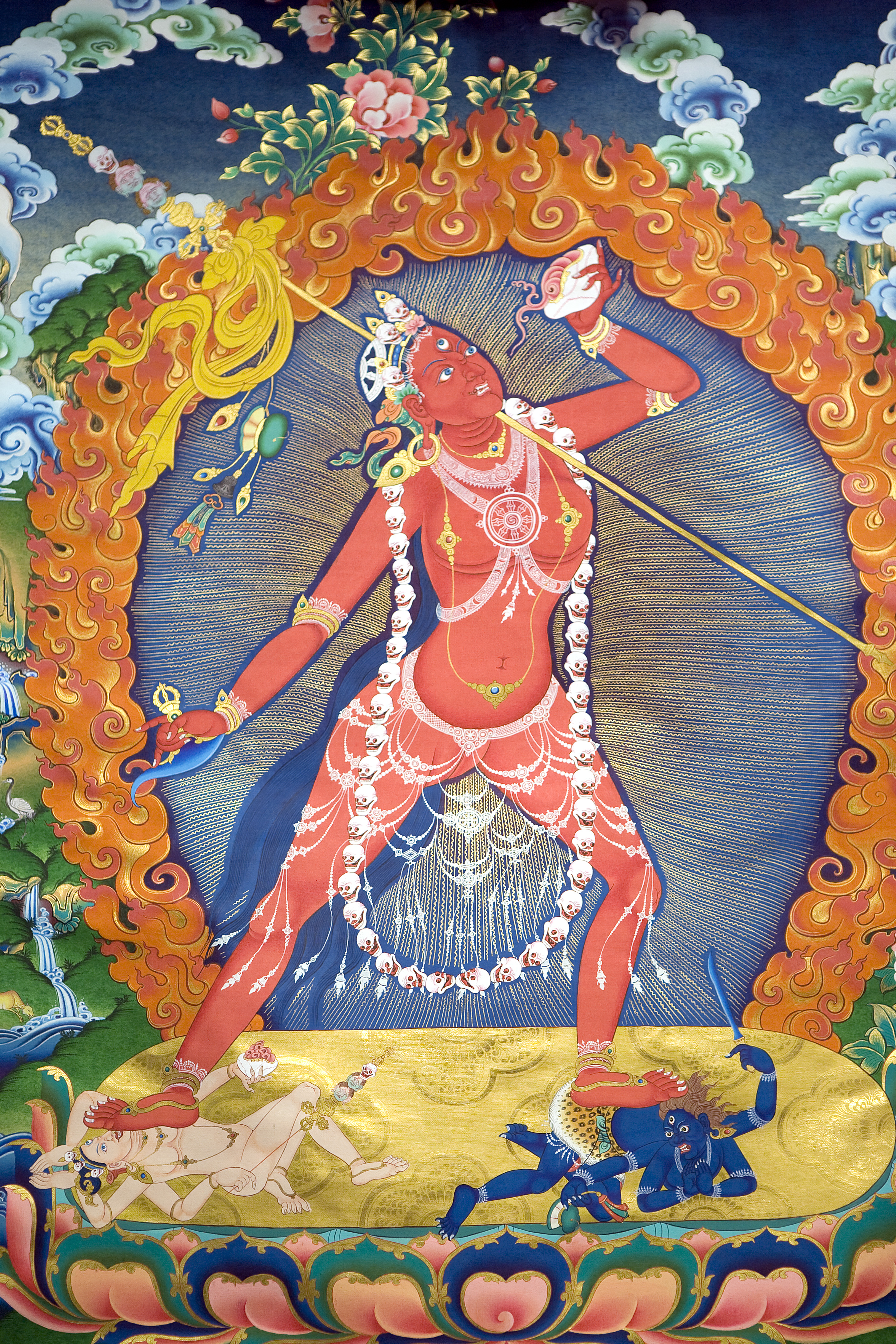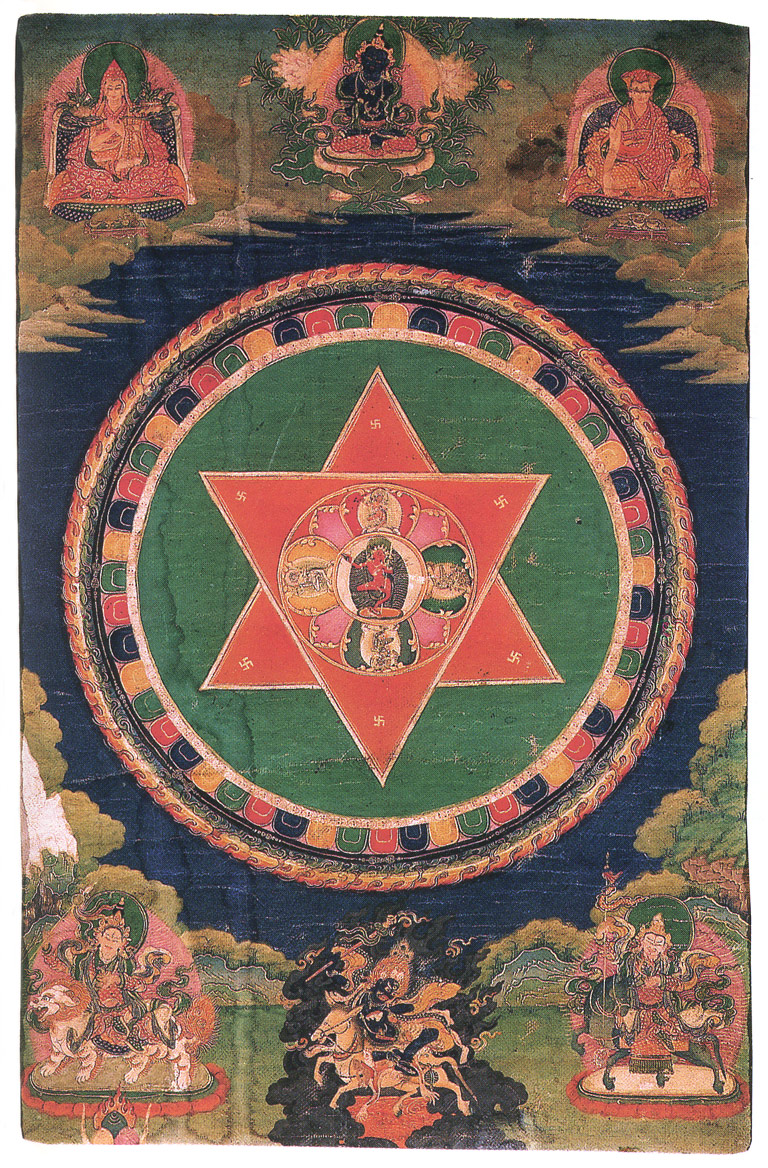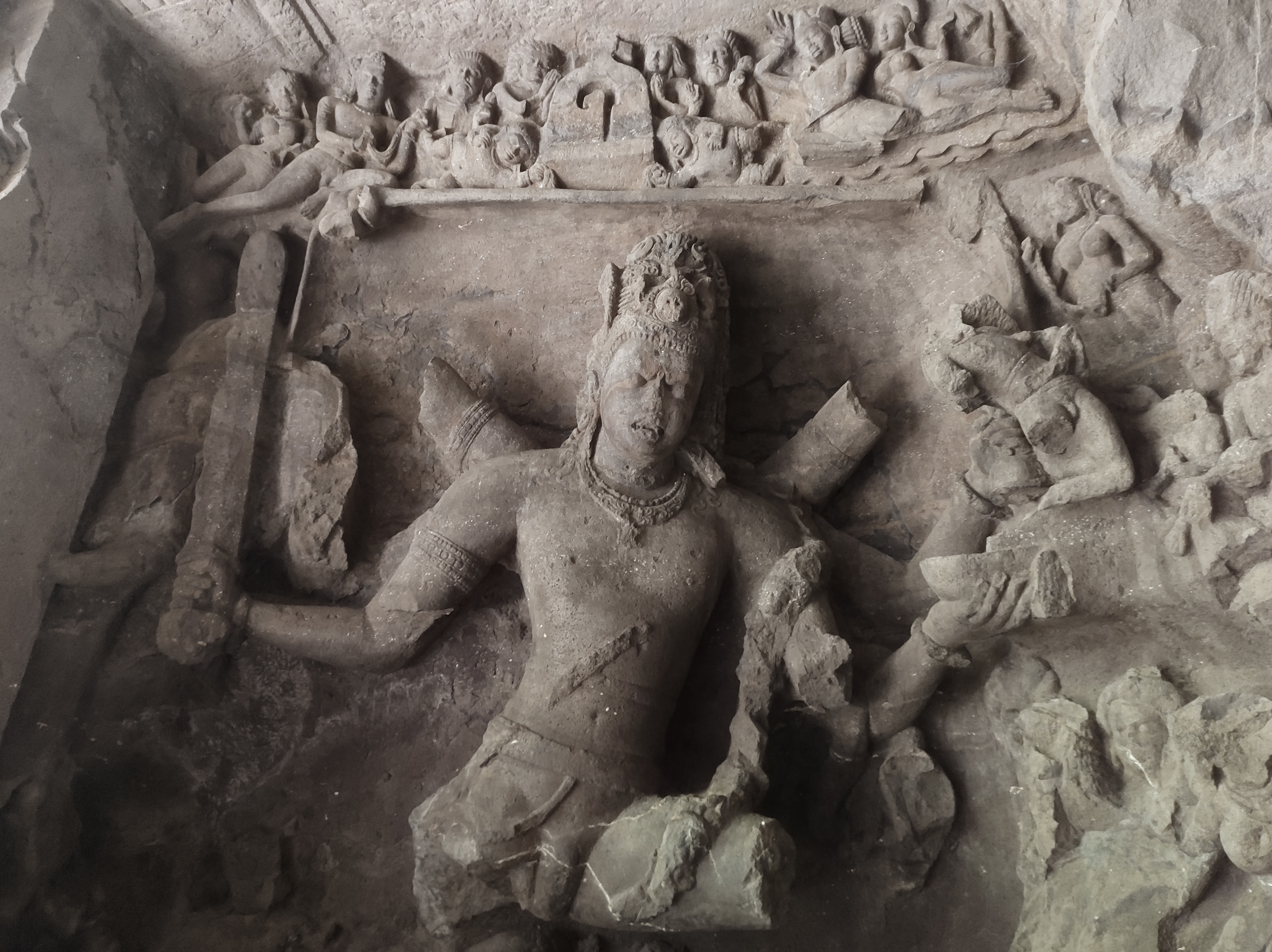|
Vajravārāhī
In Tibetan Buddhism, Vajravārāhī ("The Indestructible Sow", Dorje Pakmo) is considered a female buddha and "the root of all emanations of dakinis". As such, Vajravarahi manifests in the colors of white, yellow, red, green, blue, and black. She is a popular deity in Tibetan Buddhism, and in the Nyingma school she is the consort of Hayagriva, the wrathful form of Avalokiteshvara. She is also associated with the ''Cakrasaṃvara Tantra'', where she is paired in yab-yum with the Heruka Cakrasaṃvara. The Vajravarahi tulku lineage is the Samding Dorje Phagmo, who are associated with the Bodongpa, a little-known school of Tibetan Buddhism. There are practices of Vajravārāhī in all schools of Tibetan Buddhism, and in the Kagyu school Vajravarahi is one of its main yidam practices. Vajravarahi is depicted as a naked, often red-skinned maiden in a dancing posture, with a kapala (skull cup) in her left hand and a khatvanga on her left shoulder, while her right hand holds ... [...More Info...] [...Related Items...] OR: [Wikipedia] [Google] [Baidu] |
Vajrayogini
Vajrayoginī (; , Dorjé Naljorma) is an important figure in Buddhism, especially revered in Tibetan Buddhism. In Vajrayana she is considered a female Buddhahood, Buddha and a . Vajrayoginī is often described with the epithet ''sarvabuddhaḍākiṇī'', meaning "the [who is the Essence] of all Buddhas". She is an Anuttarayoga Tantra meditational deity (Iṣṭadevatā (Buddhism), iṣṭadevatā) and her practice includes methods for preventing ordinary death, intermediate state (bardo) and rebirth (Saṃsāra, samsara) by transforming them into paths to enlightenment, and for transforming all mundane daily experiences into higher spiritual paths. The origins of Vajrayoginī teachings date from between the 10th and 12th centuries, and draw inspiration from Hindu Tantra#Śaiva and Śākta tantra, Shaiva tantras. She appears as the consort of Padma Thotreng Tsal, and of Cakrasaṃvara, while in Vajrayoginī standalone practice, her inseparable consorts are represented by the kh ... [...More Info...] [...Related Items...] OR: [Wikipedia] [Google] [Baidu] |
Samding Dorje Phagmo
The Samding Dorje Phagmo () is the highest female tulku, incarnation in Tibet''The Power-places of Central Tibet: The Pilgrim's Guide'', (1988) p. 268. Keith Dowman. . and the third highest-ranking person in the hierarchy after the Dalai Lama and the Panchen Lama. She was listed among the highest-ranking reincarnations at the time of the 5th Dalai Lama, recognized by the Tibetan government and acknowledged by the emperors of Qing dynasty, Qing China. In her first incarnation, as Chökyi Drönma (1422–1455 Common Era, CE), she was the student and consort of the famous polymath Thang Tong Gyalpo, who first identified her as an emanation of Vajravārāhī, and the consort of Bodong Panchen. The seat of the Samding Dorje Phagmo is at Samding Monastery, in Tibet. History and background The seat of the Samding Dorje Phagmo is at the Samding Monastery "Temple of Soaring Meditation." The Samding Monastery is associated with the Bodongpa, Bodong school of Tibetan Buddhism. It was unique ... [...More Info...] [...Related Items...] OR: [Wikipedia] [Google] [Baidu] |
Cakrasaṃvara Tantra
The ''Cakrasaṃvara Tantra'' (, ''khorlo demchok,'' The "Binding of the Wheels" Tantra, ) is an influential Buddhist Tantra. It is roughly dated to the late 8th or early 9th century by David B. Gray (with a '' terminus ante quem'' in the late tenth century). The full title in the Sanskrit manuscript used by Gray's translation is: ''Great King of Yoginī Tantras called the Śrī Cakrasaṃvara'' (''Śrīcakrasaṃvara-nāma-mahayoginī-tantra-rāja''). The text is also called the ''Discourse of Śrī Heruka'' (''Śrīherukābhidhāna'') and the ''Samvara Light'' (''Laghusaṃvara''). "Cakrasaṃvara" may also refer to the main deity in this tantra as well as to a collection of texts or "cycle" associated with the root Cakrasaṃvara tantra. Tsunehiko Sugiki writes that this "Cakrasaṃvara cycle", "is one of the largest collections of Buddhist Yoginītantra literature from the early medieval South Asian world."Sugiki, Tsunehiko. Review of ''David B. Gray, The Cakrasamvara Tantra ... [...More Info...] [...Related Items...] OR: [Wikipedia] [Google] [Baidu] |
Buddhahood
In Buddhism, Buddha (, which in classic Indo-Aryan languages, Indic languages means "awakened one") is a title for those who are Enlightenment in Buddhism, spiritually awake or enlightened, and have thus attained the Buddhist paths to liberation, supreme goal of Buddhism, variously described as Enlightenment in Buddhism, awakening or enlightenment (''bodhi''), ''Nirvana (Buddhism), Nirvāṇa'' ("blowing out"), and Moksha, liberation (''vimokṣa''). A Buddha is also someone who fully understands the ''Dharma, Dhārma'', the true nature of all things or Phenomenon, phenomena (''Abhidharma, dhārmata''), the Two truths doctrine, ultimate truth. Buddhahood (Sanskrit: ''buddhatva''; or ; zh, c=成佛) is the condition and state of being a Buddha. This highest spiritual state of being is also termed ''sammā-sambodhi'' (Sanskrit: ''samyaksaṃbodhi''; "full, complete awakening") and is interpreted in many different ways across schools of Buddhism. The title of "Buddha" is most c ... [...More Info...] [...Related Items...] OR: [Wikipedia] [Google] [Baidu] |
Yidam
A ''yidam'' or ''iṣṭadevatā'' is a meditational deity that serves as a focus for meditation and spiritual practice, said to be manifestations of Buddhahood or enlightened mind. Yidams are an integral part of Vajrayana, including Tibetan Buddhism, Chinese Esoteric Buddhism and Shingon, which emphasize the use of esoteric practices and rituals to attain enlightenment more swiftly. The yidam is one of the three roots of the inner refuge formula and is also the key element of deity yoga. Yidam is sometimes translated by the term "tutelary deity". A yidam is considered to be a manifestation of enlightened qualities and a means to connect with specific aspects of the enlightened mind. The yidam is visualized during meditation in intricate detail, with the aim of internalizing its qualities and attributes. This practice is intended to facilitate the practitioner's transformation and realization of their own innate enlightened nature. It is believed to help purify the mind, ... [...More Info...] [...Related Items...] OR: [Wikipedia] [Google] [Baidu] |
Kagyu
The ''Kagyu'' school, also transliterated as ''Kagyü'', or ''Kagyud'' (), which translates to "Oral Lineage" or "Whispered Transmission" school, is one of the main schools (''chos lugs'') of Tibetan Buddhism, Tibetan (or Himalayan) Buddhism. The Kagyu lineages trace themselves back to the 11th century Indian Mahasiddhas Naropa, Maitripa and the yogini Niguma, via their student Marpa Lotsawa (1012–1097), who brought their teachings to Tibet. Marpa's student Milarepa was also an influential poet and teacher. The Tibetan Kagyu tradition gave rise to a large number of independent sub-schools and lineages. The principal Kagyu lineages existing today as independent schools are those which stem from Milarepa's disciple, Gampopa (1079–1153), a monk who merged the Kagyu lineage with the Kadam (Tibetan Buddhism), Kadam tradition. The Kagyu schools which survive as independent institutions are mainly the Karma Kagyu, Drikung Kagyu, Drukpa Lineage and the Taklung Kagyu. The Karma Kag ... [...More Info...] [...Related Items...] OR: [Wikipedia] [Google] [Baidu] |
Tulku
A ''tulku'' (, also ''tülku'', ''trulku'') is an individual recognized as the reincarnation of a previous spiritual master (lama), and expected to be reincarnated, in turn, after death. The tulku is a distinctive and significant aspect of Tibetan Buddhism, embodying the concept of enlightened beings taking corporeal forms to continue the lineage of specific teachings. The term "tulku" is a loanword from Tibetan སྤྲུལ་སྐུ ("sprul sku"), which originally referred to an emperor or ruler taking human form on Earth, signifying a divine incarnation. Over time, it evolved within Tibetan Buddhism to denote the corporeal existence of certain highly accomplished Buddhist masters whose purpose was to ensure the preservation and transmission of a particular lineage. The tulku system originated in Tibet, particularly associated with the recognition of the second Karmapa in the 13th century. Since then, numerous tulku lineages have been established, with each tulku having a ... [...More Info...] [...Related Items...] OR: [Wikipedia] [Google] [Baidu] |
Bhairava
Bhairava (, ), or Kāla Bhairava, is a Shaivite and Vajrayāna deity worshipped by Hindus and Buddhists. In Shaivism, he is a powerful manifestation, or avatar, of Shiva.Kramrisch, Stella (1994). ''The Presence of Śiva''. Princeton, NJ: Princeton University Press. p. 471. In the tradition of Kashmir Shaivism, Bhairava represents the Supreme Reality, synonymous to Para Brahman. Generally in Hinduism, Bhairava is also called Dandapāni (" e who holds thedanda in ishand"), as he holds a rod or ''danda'' to punish sinners, and Svaśva, meaning, "he whose vehicle is a dog". In Vajrayana Buddhism, he is considered a fierce emanation of boddhisatva Mañjuśrī, and also called Heruka, Vajrabhairava, Mahākāla and Yamantaka. Bhairava is worshipped throughout India, Nepal, Indonesia, Sri Lanka, and Japan, as well as in Tibetan Buddhism. Etymology Bhairava originates from the word ''bhīru'', which means "fearsome". Bhairava means "terribly fearsome form". It is also kn ... [...More Info...] [...Related Items...] OR: [Wikipedia] [Google] [Baidu] |
Kali
Kali (; , ), also called Kalika, is a major goddess in Hinduism, primarily associated with time, death and destruction. Kali is also connected with transcendental knowledge and is the first of the ten Mahavidyas, a group of goddesses who provide liberating knowledge. Of the numerous Hindu goddesses, Kali is held as the most famous. She is the preeminent deity in the Hindu tantric and the Kalikula worship traditions, and is a central figure in the goddess-centric sects of Hinduism as well as in Shaivism. Kali is chiefly worshipped as the Divine Mother, Mother of the Universe, and Divine feminine energy. The origins of Kali can be traced to the pre-Vedic and Vedic era goddess worship traditions in the Indian subcontinent. Etymologically, the term ''Kali'' refers to one who governs time or is black. The first major appearance of Kali in the Sanskrit literature was in the sixth-century CE text '' Devi Mahatmya''. Kali appears in many stories, with the most popular one bein ... [...More Info...] [...Related Items...] OR: [Wikipedia] [Google] [Baidu] |
Samding Monastery
Samding Monastery () "The Temple of Soaring Meditation" is a 13th century gompa built on a hill along a narrow peninsula that juts into Yamdrok Lake, southwest of Lhasa and about east of Nangkatse, in Tibet. It is associated with the Bodong, the Nyingma, and the Shangpa Kagyu schools of Tibetan Buddhism. Samding Monastery is the seat of Dorje Pakmo, the highest female incarnation in Tibet, and as Vajravarahi she is the consort of the wrathful deity Hayagriva Hayagriva ( IAST , ) is a Hindus, Hindu deity, the horse-headed avatar of Vishnu. The purpose of this incarnation was to slay a Danava (Hinduism), danava also named Hayagriva (A descendant of Kashyapa and Danu), who had the head of a horse a ..., a Heruka.''The Power-places of Central Tibet: The Pilgrim's Guide'', (1988) p. 268. Keith Dowman. . Dorje Pakmo is the third highest-ranking person in the hierarchy after the Dalai Lama and the Panchen Lama. Closer to Lhasa, there is another branch of Samding Monaster ... [...More Info...] [...Related Items...] OR: [Wikipedia] [Google] [Baidu] |








